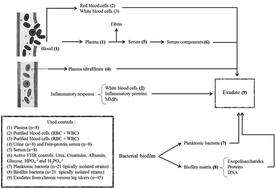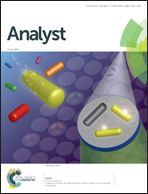FTIR spectroscopy of chronic venous leg ulcer exudates: an approach to spectral healing marker identification
Abstract
Chronic venous leg ulcer (CVLU) arises as a chronic venous insufficiency complication and is a major cause of morbidity throughout the world. Our hypothesis is that the CVLU exudate composition is a biochemical representation of the wound clinical state. Then, Fourier Transform Infrared (FTIR) spectroscopy could be a useful and less-invasive technique to study the clinical state of the ulcer. For this, the aim of this work was to perform a spectral characterization of the exudate from CVLU using FTIR spectroscopy to identify potential healing markers. 45 exudate samples from CVLU, 95% of the strains isolated from CVLU in planktonic and biofilm phenotypes and other related biological samples such as human plasma, serum, urine, blood cells, urea, creatinine, glucose and albumin were studied by FTIR spectroscopy. According to the vibration frequency of biomolecules’ (lipids, proteins, nucleic acids and carbohydrates) characteristic bonds in the infrared region, different spectral windows were selected and spectral areas of each window were measured. Besides, Savitzky–Golay second derivatives were obtained for all spectra and peaks from each standardized window were detected. FTIR spectroscopy allowed identification of sample types (exudate, plasma, serum, urine) as each one presents a unique relative composition and ratios range. Also, this technique could be useful to identify bacteria in the phenotypic-ulcer state and allows differentiation of whether bacteria are in the biofilm or planktonic form which is unlikely by conventional methods. In this work we found some spectral markers (areas, peaks) that allow identification of several parameters in the exudate such as (a) total cellularity, (b) inflammatory cell load, (c) bacterial load, (d) fibrin amount, and (e) inflammatory proteins. Because the measured areas or founded peaks are concentration-dependent this method could also serve to measure them. Therefore, FTIR spectroscopy could be useful to evaluate patient evolution as all these exudate parameters represent critical negative markers for wound healing.

- This article is part of the themed collections: Analyst Recent HOT articles and Clinical spectroscopy


 Please wait while we load your content...
Please wait while we load your content...